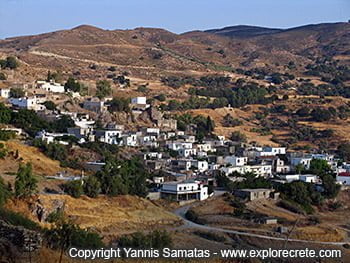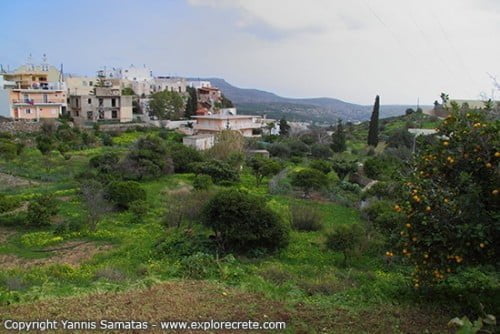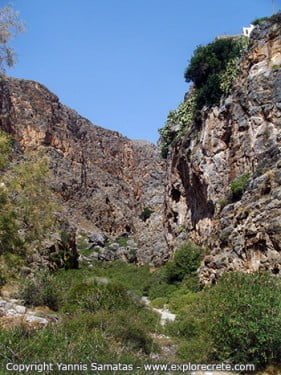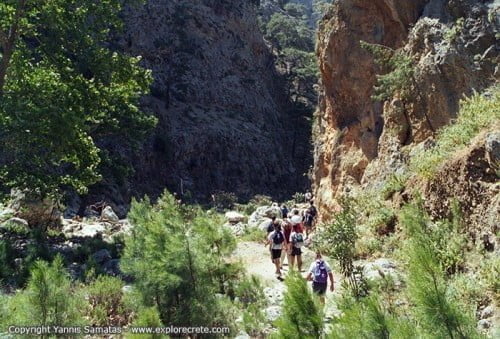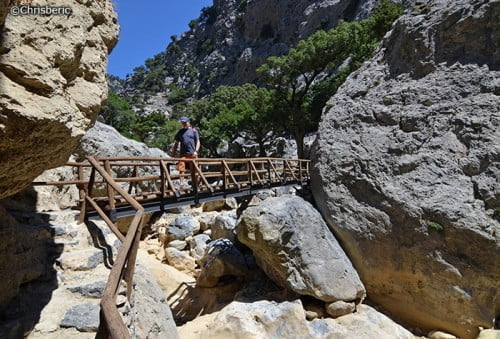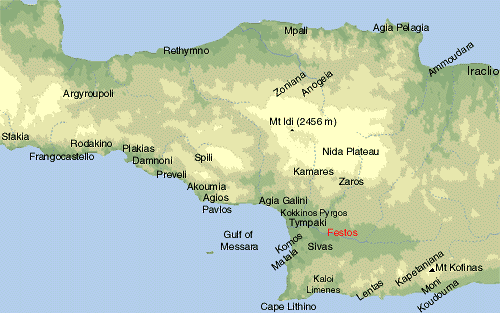Mount Kofinas in South Crete
Kofinas (1,231 metres) is the highest peak of the Asterousia Mountains, the range running across the whole southern part of Heraklion Prefecture along the coast, like a wall which once protected the heart of Crete from the prying eyes and intentions of pirates and other enemies.
Mt Kofinas – Kapetaniana – Koudoumas Monastery on Google map
Mount Kofinas takes its name from the shape of the peak, which from the north looks like an upside-down pannier (kofini).
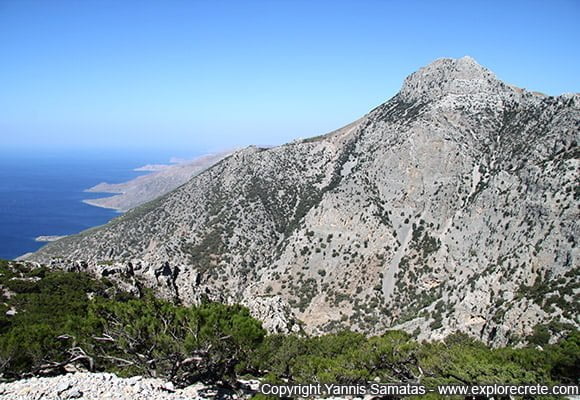
It is thrilling to stand on the flat peak of Kofinas, with the south coast of Crete spread out below you, every cape and cove visible from Tris Ekklisies to the east to Lendas, Kali Limenes and Mt Kefali to the west.
This beautiful sight impressed the ancient inhabitants of Crete, the Minoans, who built a peak sanctuary here. It is also said that in January, to somebody standing in the Great Court of the Palace of Phaistos the sun seems to rise directly over the peak of Kofinas.
Later the new religion, Christianity, succeeded the older ones and on the peak of Kofinas was built the tiny church of Timios Stavros (the Holy Cross), whose feast-day is celebrated on 14 September. There is a corresponding church of the same name on the peak of Mt Psiloritis.
The landscape of Mt Kofinas
Kofinas is a mountain whose appearance changes depending on the side you see it from. From the north, its peak seems broad and flat, while from the side it looks more like a rounded pyramid.

The landscape of Kofinas also changes dramatically from the north to the south side. In the photos below you first see the south slope of Kofinas with its grey rocks and sparse pinewood, while in the picture on the right you see Kofinas from the north, with a landscape reminiscent of African desert.
Looking at these two radically different views of Kofinas, you would be forgiven for thinking they are two different mountains. But it is actually the same mountain, and the photographs were taken on 14 and 15 August, so the change in the landscape is not a question of a change in season.
The desertification of the north side is mainly due to overgrazing by the sheep and goats of the local shepherds. Their numbers are too great for the mountain to support, so they eat any plants as soon as they emerge from the soil.
Why is there no overgrazing on the south side? Perhaps because the slopes are too steep even for goats. The land-ownership situation may also be different due to the nearby Koudoumas Monastery.
The apples of Kofinas
On the eve of the Feast of the Cross, the faithful from nearby villages climb Kofinas with the priest and hold an ancient rite of tree-worship, common in antiquity but now only preserved in a few parts of Greece.
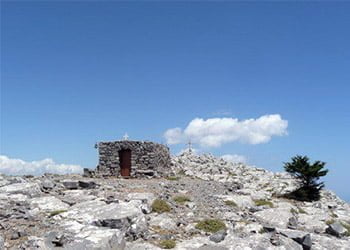
On the peak grow three special trees, the “Little Apple Trees of Kofinas”, whose fruit resembles tiny apples the size of a bean.
These trees are not actually apple trees but Balkan Whitebeam (Sorbus umbellata var. cretica).
The tiny “apples of Kofinas” are gathered by the faithful, left in water overnight and blessed next day by the priest. He distributes them to the people, who eat them for their healing properties.
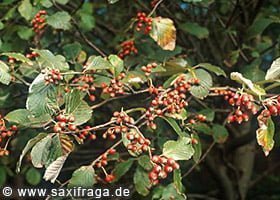
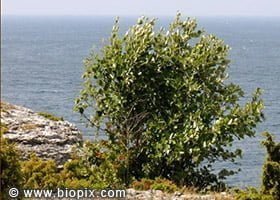
I do not know the origin of this custom, but according to a local tradition, the trees grew from the blood of an unfortunate woman who was killed climbing the peak to worship at the church.
Climbing Mount Kofinas
Climbing the Mount Kofinas is quick and easy as long as you are not afraid of heights. There is no real path, but you climb a sort of staircase formed by the rocks on the north side of Kofinas. It is best not to attempt this on your own in case you get into difficulties.
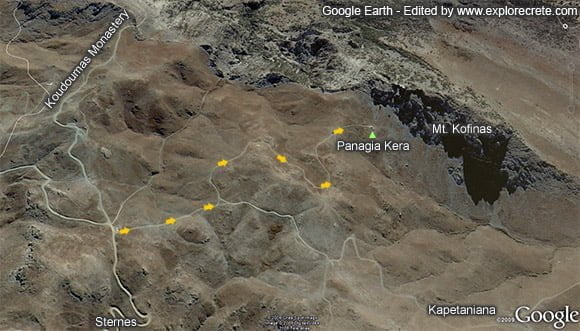
The climb up to Kofinas starts at the little church of Panagia Kera (Our Lady) at the base of the peak. You can get here either by the dirt road from the village of Kapetaniana or by that from Sternes.
From Sternes, take the road to Koudoumas Monastery. When you reach the plateau at the highest point of the mountain and see the peak of Kofinas in front of you, don’t descend to the monastery but turn right to reach Panagia Kera in 5 minutes’ drive. Leave your car here and start climbing. It’s probably no more than 200 metres high, so it should only take you 15-20 minutes.
When you reach the flat peak of Kofinas with its panoramic view, you will feel it’s well worth the effort.
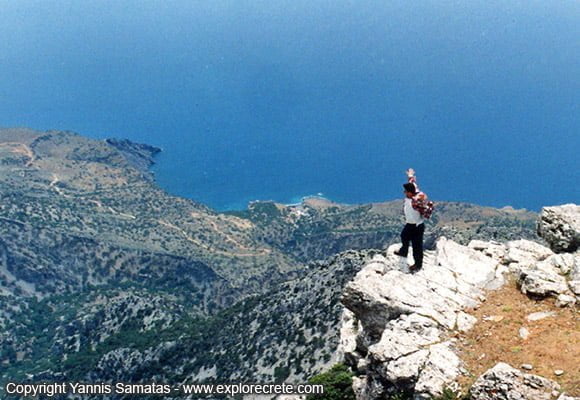
If, for some reason, you don’t make it to the peak, don’t worry – you can enjoy almost the same view from the road down to Koudoumas Monastery.
Marathon race at Kofinas
Every year, on the first Sunday of April, athletes from across Greece come to run the Kofinas Marathon. The race is organised by Kofinas Municipality and originated in a vow to the Virgin of Koudoumas Monastery.
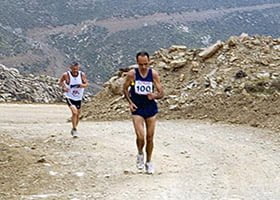
The marathon runners, along with anyone else who wants to walk or test his long-distance running abilities, start from Sternes and cover the full 24-kilometre course to Koudoumas Monastery. The bravest cool off with a dip in the Libyan Sea, while a dinner is set out for all, athletes and spectators alike.
Kofinas Horse Races
Kofinas Municipality also organises horse races in Loures village on 5 and 6 May each year. The races, attended by people from all over Greece, are held in honour of St Irene, whose feast-day is on 5 May.
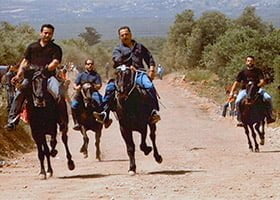
Well done to Kofinas Municipality for organising these remarkable sporting events – if only the other municipalities of Crete would follow their example!
© explorecrete.com All Rights Reserved. Reproduction or copying without permission is prohibited.

